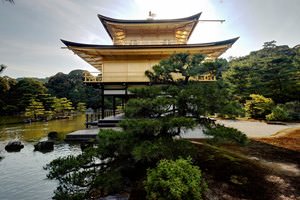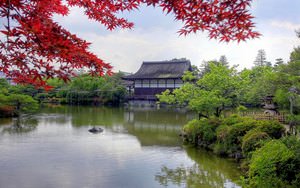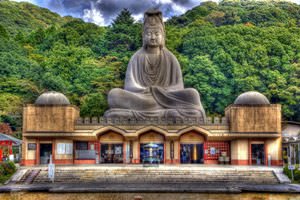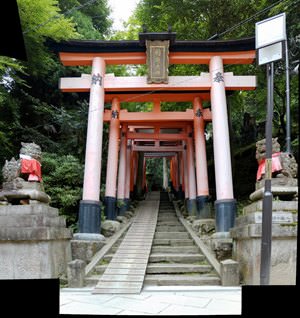 Kyoto has been preserving the status of the cultural capital of Japan for many years. It is an amazing city that managed to preserve old-world charm over the centuries. There are beautiful Buddhist temples and palaces, exquisite gardens with fountains and sculptures - historical and architectural monuments of different ages has survived in the city.
Kyoto has been preserving the status of the cultural capital of Japan for many years. It is an amazing city that managed to preserve old-world charm over the centuries. There are beautiful Buddhist temples and palaces, exquisite gardens with fountains and sculptures - historical and architectural monuments of different ages has survived in the city.
Many entertainment venues in Kyoto will help to diversify the rich excursion program; anyone could find a place to stay at his liking. Travelers coming to vacation with kids are sure to …  Open
Open
1. Major shopping centers are open every day, seven days a week. They begin serving visitors not later than 10:00 am, and the working day ends not earlier than 9:00 pm. If the store is …  Open
Open
 In the historic district of Kyoto Imperial Palace is located. The total area of this large-scale construction makes out 84 hectares. It became available for a free visit quite recently, in 1946. Detailed tour of the palace includes a visit to the most beautiful rooms, durbars and cozy patios. The Nijo castle is also important historical object. A powerful defensive structure impresses with its size and grandeur; a walk through the castle will bring a lot of impressions. This is only a small part of the amazing attractions that visitors can see in Kyoto.
In the historic district of Kyoto Imperial Palace is located. The total area of this large-scale construction makes out 84 hectares. It became available for a free visit quite recently, in 1946. Detailed tour of the palace includes a visit to the most beautiful rooms, durbars and cozy patios. The Nijo castle is also important historical object. A powerful defensive structure impresses with its size and grandeur; a walk through the castle will bring a lot of impressions. This is only a small part of the amazing attractions that visitors can see in Kyoto.
Kyoto has plenty of shopping spots to choose from. Here you can start shopping right at the railway station. The Kyoto Station Building is one of the largest stations not only in the country …  Open
Open
 To get acquainted with other Kyoto's traditional crafts, be sure to explore the Kyoto Museum of Traditional Crafts Fureaikan. Its visitors will plunge into the world of glass making, pottery, Japanese fine arts, calligraphy. Moreover, at the exit one can find a shop with souvenirs, all of which are unique. On certain days, workshops on various crafts are held in the museum. Those who are keen on manga and anime will be thrilled with the opportunity to visit the Kyoto International Manga Museum. Thousands of “Japanese comic book” volumes (which are sometimes called “komikku”), autographs of famous manga writers, and original editions are just a small part of what can be found here. Not to mention hundreds of people passionate about comics - after all, there’s no better place to read favorite manga stories than the museum's inner courtyard.
To get acquainted with other Kyoto's traditional crafts, be sure to explore the Kyoto Museum of Traditional Crafts Fureaikan. Its visitors will plunge into the world of glass making, pottery, Japanese fine arts, calligraphy. Moreover, at the exit one can find a shop with souvenirs, all of which are unique. On certain days, workshops on various crafts are held in the museum. Those who are keen on manga and anime will be thrilled with the opportunity to visit the Kyoto International Manga Museum. Thousands of “Japanese comic book” volumes (which are sometimes called “komikku”), autographs of famous manga writers, and original editions are just a small part of what can be found here. Not to mention hundreds of people passionate about comics - after all, there’s no better place to read favorite manga stories than the museum's inner courtyard.
Discovering the architecture of Kyoto from bird's eye view! Kiyomizu-dera, Kyoto Tower, Tenryu-ji Temple, Chion-in, all those monuments are defining the image of Kyoto …  Open
Open
 Gion is a district traditionally associated with geisha. In fact, this is the real “geisha district” where you can find authentic streets striking with their unsurpassed national flavor, along which ladies dressed in kimonos walk. Visiting one the many kabuki theaters (and, of course, the most important one - "Gion Kobu Kaburenjo") is a must-have. During the show, Japanese beauties demonstrate the art of the tea ceremony, ikebana, dance, and puppetry. Walking through the district, be sure to visit one of the tea houses and try the traditional drink in the appropriate atmosphere.
Gion is a district traditionally associated with geisha. In fact, this is the real “geisha district” where you can find authentic streets striking with their unsurpassed national flavor, along which ladies dressed in kimonos walk. Visiting one the many kabuki theaters (and, of course, the most important one - "Gion Kobu Kaburenjo") is a must-have. During the show, Japanese beauties demonstrate the art of the tea ceremony, ikebana, dance, and puppetry. Walking through the district, be sure to visit one of the tea houses and try the traditional drink in the appropriate atmosphere. City tours, excursions and tickets in Kyoto and surroundings
Plan your own excursion through Kyoto: churches, museums and castles
Kyoto National Museum, Kyoto
Location on the map:  Facts:
Facts:
» The Kyoto National Museum is a red brick building. Its total area is 50 thousand m2. » The new building built in 1966 houses permanent collections including pieces of Asian arts. 12 000 exhibits are placed into three sectors. 230 exhibits are national Japanese treasures.
» The collection includes exhibits that have been kept in temples, royal palaces, and personal houses before. There are 200 000 photos.
» The showroom is divided into three sections. The first one, “beaux-arts”, presents sculptures, paintings, and calligraphy. The second section, “handcraft”, presents ceramic items, woven fabrics, and home-made lacquer and metal works. Tea cups, Japanese chawan, are very attractive. They are covered with glaze and were made in the 12th century. The third section is dedicated to archeology and archeological relics.
» Besides, there is the Meiji Kotokan Hall (the tomb of the imperial family) in the territory of the museum. It is a small tea house where you can see the garden with fountains, stone statues of Buddha, Korean stone sculptures, and how tea is made in accordance with age-old traditions.
Tenryu-ji Temple, Kyoto
Location on the map:  Facts:
Facts:
» Tenryu-ji Temple is the “Dragon of the Sky”. As the legend says, it was named like this because the priest dreamed about the golden serpent flying from the river. It was interpreted as a wayward soul. The Buddhist temple was built as a sanctuary in memory of the Emperor. » To cover the construction costs, subordinates had to trade with China.
» The main building was destroyed in a fire. The contemporary reconstruction lets see the original exterior of the building. The temple possesses about 30 hectares of land.
» You can see a dragon on the ceiling of the Hall of Sermons. The picture is unusual because the dragon’s gaze is always fixed on the visitor.
» Visitors are offered to taste vegetarian dishes, the recipes of which have been preserved from the time of the first Buddhist monks.
» The garden with a big pond planted in the 14th century is also distinguished by its nature. The nearby hills are a sort of the next level of the park.
» There is a stone “waterfall” in the center of the garden. The rocks are placed in the way that they resemble the streaming water.
» There are tombs of the nobles in the territory of the temple. In Tenryu-ji, you can go through the gate to the lecture and meditation hall.
» it is accustomed to place a coin into the wooden box in front of the house of prayer.
Sanjusangen-do, Kyoto
Location on the map:  Facts:
Facts:
» The 118-meter temple was founded in 1164. The Japanese word means “the Hall of 33 Stairs” or wooden pillars upholding the foundation. » The sanctuary is dedicated to Goddess Kannon, a protector from troubles. She is reflected in 1001 sculptures. They are kept in the central hell.
» There is big statue Kannon (the goddess with a hundred arms) in the shadow on the lotus. There are gilded figurines in 10 rows, 50 items in a tier. Each figurine is unique as it has its own facial expression and dress. Sculptures are made of camphor laurel. They are covered with gilt. They were made in the 12th-13th centuries.
» The narrow construction with a width of 18 meters stretches from the north to the south and is considered as the longest wooden construction in the world. The building has a tiled roof with smooth curves.
» Competitions in Japanese crossbow shooting in the territory of the complex. As the legend says, the samurai fired 13 thousand arrows, 8 thousands of which met the goal.
» The earth wall surrounding the temple and the entrance gate of the 16th century are also very interesting.
» Before crossing the threshold of the building, you must wash your hands. Near the temple, there is a garden planted according to the traditions of Japanese arts.
Nijo Castle, Kyoto
Location on the map:  Facts:
Facts:
» The building was built in 1626. The castle is the shelter of Kyoto rulers. The name of the castle is similar to the name of the road where it is located. » You can enter the complex only through the gate on the eastern side. The territory is fenced with stone walls and ponds. There is a Japanese garden with a pond, rocks, and pines growing on islets.
» The inner area is protected by several rings.
» The park is famous for cherry trees growing here. They bloom by the end of April. Maples and ginko (relict) trees make the landscape more beautiful.
» The castle includes several separate constructions. They are linked with hallways. They are distinguished by a squeaky floor with special covering that squeaks when coming into contact with something.
» 33 luxurious rooms are tiled with special mats. The rooms are separated by sliding doors with colorful patterns. The walls in the conference room are decorated with painted herons and fancy flowers. Living rooms feature pictures with sleeping sparrows against the black-and-white background.
» The collection of 3 thousand paintings is kept here.
» The guards' rooms are so disguised that it is impossible to see them inside the paper walls.
Imperial Palace, Kyoto
Location on the map:  Facts:
Facts:
» Several buildingы of the Imperial Palace were built in 1855. Original constructions were destroyed in a fire. Almost a thousand journeymen reconstructed them. » One of the palace, “Omya”, is a holiday home for the members of the Royal Family visiting Kyoto.
» The territory of the Palace is protected by long massive white walls with brown faded beams. There are 6 gates. The complex is 1 300 m long and 700 m wide.
» The free zone is available for tourists. Alleys are covered with gravel. In the park, you can see pines, cherry trees, and maples.
» One of the palaces includes the audience hall. There is a monarch’s room in the other one. There is also the Empress’s Room and the Study Room.
» The Imperial Palace saw 28 generations of rulers living here.
» The rooms are separated by sliding panels. On the partition walls, you can see pictures of flowers and animals and images from Lives of the Saints.
» All the constructions of the palace have its functions: the refectory, prayer rooms, the meeting room, household buildings, and warehouses.
» Roof ridges have the shape of arms and depict chrysanthemums.







